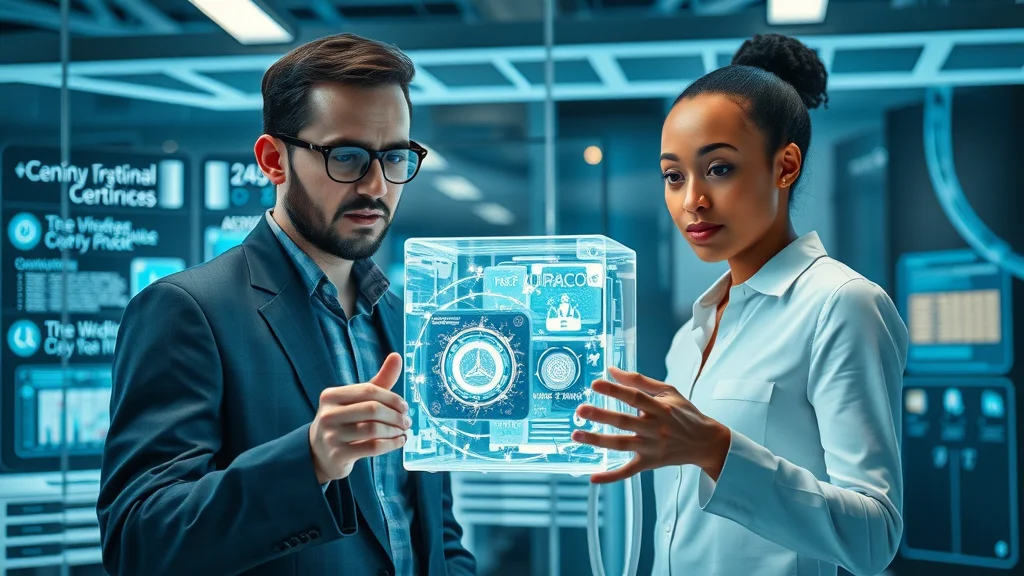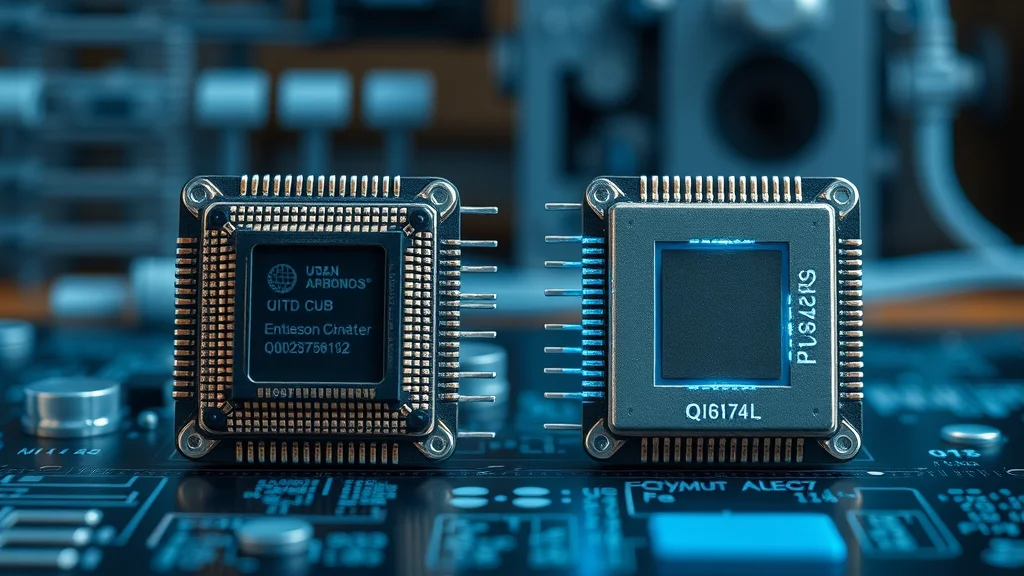By 2030, quantum computing is projected to solve problems that would take classical computers millennia. Imagine computers so powerful they can decode secrets of the universe, invent new medicines in hours, and secure our digital world like never before. This guide will make quantum computing accessible for everyone, even if you’re just starting out. Looking for a sneak peek into the next revolution in technology? Let’s dive in and unlock the quantum world together!
Unveiling Quantum Computing: An Unexpected Revolution
Startling statistic: By 2030, quantum computing is projected to solve problems that would take classical computers millennia.
Quantum computing is not just another leap in technology—it’s a paradigm shift. Unlike classical computers, which crunch numbers in straightforward, logical ways, quantum computers rely on the strange laws of quantum mechanics. This means they can process information in entirely new ways, making them ideally suited to tackle complex problems that traditional computers simply can’t. From revolutionizing machine learning to tackling optimization challenges and opening up new frontiers in computer science, quantum computers are set to change how we approach age-old questions.
This revolution matters because the problems that quantum computers can solve—think climate modeling, drug discovery, or breaking traditional encryption—are some of humanity’s toughest. With a quantum computer, solving these once “impossible” problems becomes not just possible, but efficient. Whether you’re curious, career-minded, or simply want to stay informed about the rapidly evolving field of quantum computing, this guide will help you understand the basics and future possibilities of quantum tech.

What You’ll Learn About Quantum Computing
- Definition of quantum computing
- The key differences between quantum computers and classical computers
- How quantum mechanics underpins quantum computing
- The current state and real-world applications of quantum computing
- Future prospects and quantum advantage
Understanding the Basics: What is Quantum Computing?
Quantum Computing in Simple Terms
At its core, quantum computing uses the principles of quantum mechanics to process information. While classical computers rely on bits—tiny switches that are either off (0) or on (1)—quantum computers use qubits. These quantum bits can be both 0 and 1 at the same time, thanks to a phenomenon called superposition. This unique ability lets a quantum computer perform calculations that would take ordinary computers ages to complete. Instead of a long line of workers, imagine having a whole team tackling every part of the problem at once!
If you’ve ever wondered how Google can sift through billions of web pages in seconds or how scientists simulate molecules to create new medicines, it’s because of a computer’s processing power—but even our top supercomputers have limits. Quantum computers, by leveraging superposition and a related phenomenon called entanglement, can break through these bottlenecks. In essence, they bring a whole new toolbox for handling complex problems. If you’re new to terms like quantum mechanics or qubits, don’t worry—you’ll soon find them easier than you think! Now, let’s see how quantum computing stands against the technology we know best: classical computers.

As you explore the foundational concepts of qubits and superposition, it’s also valuable to understand how businesses are preparing for this technological leap. For a practical look at how organizations can get ready for the quantum era and what it means to create a qubit fit for real-world applications, check out this guide on preparing your business for quantum computing.
Classical Computing vs Quantum Computing
- Bit vs Qubit
- Superposition and Entanglement
- Comparing processing power
A classical computer works with bits—each bit is either 0 or 1, nothing in between. Think of these bits as light switches: they’re either on or off, and your classical computer is like a long hallway filled with millions of these switches. In contrast, quantum computers use qubits, which can be in a state of 0, 1, or both 0 and 1 simultaneously. This state of being “both” is called superposition. Furthermore, entanglement lets multiple qubits link together, so changing one will instantly affect the other, even across great distances—a property classical computers simply can’t match.
This new way of storing and processing data leads to a drastic increase in computing performance. While a classical computer tests each solution one by one, a quantum computer can test many possibilities at once, thanks to superposition. As quantum computers scale up, their power grows exponentially—not just step by step as with classical computers. So, for certain complex problems, quantum computing can deliver results in seconds that would take classical machines years, or even millennia, to solve.
| Attribute | Classical Computer | Quantum Computer |
|---|---|---|
| Basic Unit | Bit (0 or 1) | Qubit (0, 1, or both via superposition) |
| Processing | Sequential or limited parallel | Massive parallelism through superposition |
| Entanglement | None | Yes (linked quantum states) |
| Speed Scaling | Linear | Exponential |
| Best for | Basic tasks, everyday use | Complex problems requiring high computation |
"Classical computers handle data in bits—quantum computers juggle probability in qubits."

How Does Quantum Computing Work?
The Role of Quantum Mechanics in Quantum Computing
Quantum computing is possible thanks to the mind-bending concepts of quantum mechanics, the physics that governs the smallest building blocks of our universe. Quantum mechanics reveals particles behaving in ways that seem impossible—being in two places at once or instantly influencing each other across vast distances. In field of quantum computing, these principles are harnessed to manipulate quantum bits and quantum states. Superposition allows a qubit to represent multiple possible outcomes, while entanglement means two qubits can operate as a linked pair, no matter how far apart they are in a quantum system.
In a quantum computer, these effects translate into powerful new ways of processing information. For example, instead of having to try every possibility one by one (as in a classical computer), a quantum computer can explore many possibilities at once. When you run a quantum algorithm on a quantum system, you’re basically using quantum mechanical properties to search for answers faster than any classical machine could hope to do.

Key Components: Qubits, Gates, and Quantum Circuits
- Qubits: The smallest unit in quantum computers
- Quantum gates: Manipulating qubits
- Quantum circuits: Carrying out computations
The building blocks of every quantum computer are qubits. Unlike a classical bit, a physical qubit can hold complex quantum information. These can be implemented in several ways—super-cooled circuits, trapped ions, or even photons. Once you have qubits, you need a way to control and process them. That’s where quantum gates come in. Similar to logical gates in a classical system, quantum gates manipulate the quantum states of qubits—turning superpositions on or off, entangling qubits, and so on. By stringing together a sequence of gates, scientists create quantum circuits, which execute quantum algorithms designed to solve complex problems.
The power of a quantum circuit grows rapidly as more qubits are added. Every additional qubit doubles the amount of information that can be encoded and processed, leading to what scientists call exponential scaling. This is why a quantum computer with just 50–100 qubits could, in theory, perform calculations impossible for the largest classical supercomputers available today.
"A single qubit can represent both 0 and 1 at the same time, unlocking quantum advantage."
Classical Computing vs Quantum Computing: Key Differences
Performance: Speed and Scale
- Parallel computing and exponential scaling with quantum computers
- Limitations of classical computing
When it comes to sheer speed, quantum computers have the potential to outpace classical computers by a staggering degree. This is due to their use of superposition and entanglement, which allow them to process vast amounts of data at once. In contrast, classical computers process data sequentially or with limited parallelism, meaning they are much slower at solving certain types of complex problems. For example, searching for a password in a list of possibilities, a task that may take classical computers years, could take a quantum computer just minutes or even seconds.
Nevertheless, there are still limitations. Classical computers excel at everyday tasks, such as running your operating system or browsing the internet. Quantum computers, on the other hand, are best for specialized tasks where exponential scaling can actually be put to use. This massive parallel computing power could transform industries where speed—and the ability to handle huge quantities of data at once—really matters.

| Metric | Classical Computer | Quantum Computer |
|---|---|---|
| Processor Speed | Measured in GHz, limited by heat and chip size | Potential for breathtaking speed via parallelism and quantum algorithms |
| Power Usage | Growing with performance; efficiency losses at scale | Can use lower energy per computation, but requires high-tech cooling and error correction |
| Scalability | Linear increase (Moore's Law plateauing) | Exponential increase as more qubits are added |
Data Security: Quantum Cryptography vs Traditional Encryption
Another crucial difference between classical and quantum computing is in the field of security. Classical computers use traditional encryption methods, which rely on the difficulty of certain complex problems, like factoring large numbers, to protect sensitive information. Yet, quantum computers, thanks to their immense processing power and unique quantum algorithms like Shor's algorithm, could potentially break these encryptions. This is why there is a global push to develop quantum cryptography, leveraging quantum states to secure data with principles such as quantum key distribution—making it theoretically impossible for hackers to intercept data without detection.
Quantum cryptography represents both an exciting opportunity and a daunting challenge. On one hand, it could make communications virtually tamper-proof; on the other, classical systems as we know them may someday become obsolete if they are not updated to withstand attacks by quantum computers. As we integrate quantum computing more fully into industry and everyday life, keeping data secure will remain a top priority.
Applications of Quantum Computing Today
Quantum Computing in Machine Learning
- Speeding up pattern recognition
- Optimizing neural networks
Machine learning is all about finding patterns and making predictions using lots of data. Quantum computers, with their remarkable ability to process and evaluate enormous datasets simultaneously, have the promise to dramatically speed up these tasks. They can turbocharge pattern recognition and optimize neural networks more efficiently than classical computing methods. In the future, quantum machine learning could unlock higher-performing artificial intelligence, better speech and image recognition, smarter recommendations, and even more accurate weather predictions.
While current quantum computers are in the early stages, research teams around the world are actively developing quantum algorithms specifically designed for machine learning challenges. These techniques could revolutionize everything from diagnosing diseases to optimizing smart grids. Machine learning is one of the most exciting use cases that could truly benefit from the power of quantum computing, fundamentally changing how computer science and artificial intelligence progress forward.

Quantum Computers in Drug Discovery and Materials Science
- Simulating molecular interactions
- Accelerating new materials development
Another remarkable use case for quantum computers is in drug discovery and the development of new materials. Classical computers struggle to simulate the quantum behavior of molecules and atoms accurately, as these tasks require enormous computing power. Quantum computers, however, are designed to model quantum states and interactions directly, allowing researchers to better understand molecular structures and simulate molecular interactions at unprecedented speeds.
This quantum leap in computational chemistry could lead to breakthroughs in medicine, such as designing drugs more efficiently or finding cures for diseases faster. It’s also pivotal in materials science—creating new materials with properties never seen before, for example, superconductors for more efficient energy transmission or advanced solar panels. Scientists using quantum computers could revolutionize fields that affect our daily lives, health, and environment.

Solving Complex Problems: Optimization & Logistics
Optimization is at the heart of many industries, from routing delivery trucks and managing supply chains to scheduling airline flights or allocating resources in cities. These problems quickly become too complex for even the fastest classical computers to solve efficiently as the number of possibilities grows. Quantum computers, through their unique parallelism, hold the promise to find optimal solutions dramatically faster. Imagine city traffic always flowing smoothly thanks to perfect route planning or businesses saving millions by optimizing logistics with precision only quantum computing can provide.
As quantum systems mature, optimization could be one of the first areas where businesses and consumers directly see the “quantum advantage.” The ability to process vast, interconnected data and produce optimal answers has the potential to transform how we make decisions at every level—from business to government and beyond.
Real-World Quantum Computers: Where Are We Now?
Do Quantum Computers Exist Now?
Yes, quantum computers exist today! While they aren’t yet ready to replace your laptop or run video games, a number of companies and research institutions have already built early-stage quantum systems. These quantum computers are excellent at demonstrating proof-of-concept calculations and algorithms, but they’re still in the process of scaling up for commercial use. Some are even available in cloud-based “quantum as a service” models, letting researchers and developers experiment with real quantum hardware over the internet.
Big names like IBM, Google, and D-Wave have all built operational quantum computers. While these machines currently require super-cold environments and specialized setups, progress is happening fast. With each passing year, quantum hardware is improving—adding more qubits and increasing reliability—and the day may not be far off when some of our toughest complex problems are regularly solved using quantum computing.
Examples of Quantum Computers
- IBM Q System One
- Google Sycamore
- D-Wave Systems
The IBM Q System One was the world’s first circuit-based commercial quantum computer, housed in a stunning glass case and accessible via IBM’s Quantum Experience cloud platform. Google’s Sycamore made headlines in 2019 by reportedly achieving “quantum supremacy”—performing a calculation in 200 seconds that would have taken even the fastest classical supercomputer thousands of years. Meanwhile, D-Wave Systems focuses on quantum annealing, which is ideal for optimization problems. Each of these quantum computers demonstrates unique ways of using quantum bits and quantum algorithms to solve real-world challenges.

Is Quantum Computing an AI?
"While quantum computers can accelerate AI algorithms, they aren't forms of intelligence themselves."
Quantum computing and AI (Artificial Intelligence) are two different technologies, but they can work together. A quantum computer is a powerful tool that processes information using quantum mechanics, while AI refers to computer programs that can think, learn, and make decisions. Quantum computers could speed up certain AI algorithms—making them more accurate or allowing them to crunch massive datasets much faster. However, quantum computers do not “think” or possess intelligence—they simply execute tasks designed by humans or AI systems. They’re powerful engines, but it’s the algorithms and software that bring intelligence to life.
As research continues, we’ll see quantum computers and AI increasingly working together, pushing each other to new heights in machine learning, decision-making, and data analysis. This powerful duo could bring about transformative breakthroughs in every field.

Major Challenges in Quantum Computing
Quantum Error Correction and Noise
With all the promise of quantum computing, there are significant hurdles to overcome. One major challenge is quantum error correction. Qubits are surprisingly sensitive: any interference from their environment, known as “noise,” can cause quantum states to collapse or become corrupted. This means the reliability of today’s quantum computers is still fragile, requiring complex engineering and error-correcting codes to maintain accuracy. The field is making tremendous strides, but perfecting quantum error correction is one of the grand challenges to scaling up quantum technology for practical, everyday use cases.
Experts are working hard to improve the stability of physical qubits and develop advanced systems that can automatically detect and fix errors. Each breakthrough in reducing noise and correcting errors brings us closer to realizing the full power of quantum computers for solving humanity’s most complex problems.

Scaling Quantum Systems
- Engineering challenges in building large-scale quantum computers
- Thermal management and quantum coherence
Building quantum computers at scale brings an entirely new set of challenges. As more qubits are added, keeping them entangled and in sync (quantum coherence) becomes harder. These systems often need to be cooled to temperatures colder than outer space, and require extremely precise controls. Engineering solutions for thermal management and consistent qubit reliability are still a focus of cutting-edge research in the field of quantum computing.
Despite these hurdles, each year brings news of higher qubit counts and more robust hardware architectures. As these issues are solved, we’ll move closer to tipping the scales from experimental machines to powerful, commercial-ready quantum systems ready to tackle ever-larger, more complex problem sets.
Quantum Advantage: The Quest for Supremacy
"Quantum advantage marks the moment when quantum computers solve practical problems classical computers can't solve in any reasonable time."
The ultimate goal in quantum computing is achieving quantum advantage or even “quantum supremacy.” This is when a quantum computer can outperform the most advanced classical computer at a practical, real-world task. It’s a hotly contested target, with tech companies and researchers racing to be the first. While early claims of quantum supremacy have stirred excitement, for most applications, we are still preparing the groundwork: building larger quantum systems, refining quantum algorithms, and proving usefulness outside highly specialized experiments.
Reaching quantum advantage would mark a turning point in technology—ushering in a new era where certain complex problems, long considered unsolvable or impractical, suddenly have answers. This advance will reshape industries, economies, and perhaps even what’s possible in science itself. It’s a goal that inspires innovation and collaboration across the globe.

Future Prospects: The Road Ahead for Quantum Computing
- Integration with classical computers
- Commercialization and industry adoption
- Quantum computing as a service (QCaaS)
- Potential breakthroughs and disruptive innovations
The future of quantum computing is bright and full of possibilities. Soon, quantum systems will work alongside classical computing, delivering hybrid solutions that blend the best of both technologies. Industry experts predict quantum computing will move from the research lab into real-world business applications, from pharmaceuticals to finance and logistics. New models, like Quantum Computing as a Service (QCaaS), will make powerful quantum machines accessible to anyone, not just large organizations.
As more businesses and researchers start using quantum computing, the pace of breakthroughs and innovative applications will accelerate. From disrupting cybersecurity to transforming the way we handle massive data in every sector, the quantum revolution will continue to unfold—offering solutions to problems we haven’t yet imagined, and making the seemingly impossible, possible.
Frequently Asked Questions on Quantum Computing
-
What fields benefit most from quantum computing?
Industries including cryptography, machine learning, pharmaceuticals (drug discovery), logistics, finance, and materials science stand to benefit. Quantum computers are best for solving complex problems that overwhelm conventional computing methods, especially in fields dealing with huge datasets or requiring intricate simulations. -
How soon will quantum computers become mainstream?
While rapid progress is being made, mainstream quantum computing is likely several years away. Current systems are used primarily by researchers and industry leaders. As the technology matures—becoming more reliable, scalable, and accessible—we can expect broader adoption throughout the 2020s and beyond. -
How is quantum computing taught to beginners?
Beginners learn quantum computing through a mix of simple analogies, visualizations, and hands-on programming with tools like Qiskit (from IBM) or via online courses. The most important concepts are superposition, entanglement, and how quantum algorithms work. Today, many resources exist to help absolute beginners master the basics.
Key Takeaways About Quantum Computing
- Quantum computing harnesses quantum mechanics to solve complex problems far faster than classical computers.
- Current quantum computers are limited, but rapid progress is underway.
- Applications span cryptography, AI, medicine, logistics, and more.
- The quantum advantage will mark a paradigm shift in computation.

We’d Love to Hear What You Think About Quantum Computing
We'd love to hear what you think about this? Please add your comments below...
If you’re inspired by the possibilities quantum computing offers, consider how this technology is already shaping the business landscape. Major investments and leadership changes are accelerating innovation, opening new doors for organizations ready to adapt. For a deeper perspective on how industry leaders are navigating the quantum future and what these shifts mean for business strategy, explore the story behind JPMorgan’s quantum computing leadership change. Discover how forward-thinking companies are positioning themselves at the forefront of this technological revolution—and how you can leverage these insights for your own growth journey.
Quantum computing is an emerging field that leverages the principles of quantum mechanics to process information in fundamentally new ways. Unlike classical computers, which use bits as the smallest unit of data, quantum computers utilize quantum bits, or qubits. Qubits can exist in multiple states simultaneously due to a phenomenon called superposition, allowing quantum computers to perform complex calculations more efficiently than classical systems. (nasa.gov)
One of the key advantages of quantum computing is its potential to solve problems that are currently intractable for classical computers. For instance, quantum algorithms can factor large numbers exponentially faster than classical algorithms, posing both challenges and opportunities for fields like cryptography. (ibm.com)
In recent developments, researchers from Harvard and MIT have achieved a significant milestone by creating a quantum computer capable of running continuously for over two hours. This advancement addresses the challenge of “atom loss,” a key issue in quantum computing that leads to information degradation. By utilizing an “optical lattice conveyor belt” and “optical tweezers,” the team can continuously replace lost qubits—represented by atoms—at a rate of 300,000 atoms per second in a system with 3,000 qubits. This allows the quantum computer to maintain stability and potentially run indefinitely. (tomshardware.com)
Additionally, PsiQuantum, a U.S.-based quantum computing startup, has begun construction on a new facility at the Illinois Quantum and Microelectronics Park (IQMP) in Chicago, following a $1 billion Series E funding round. This facility aims to build the company’s largest intermediate-scale quantum test system, with the goal of developing the nation’s first million-qubit, fault-tolerant quantum computer. (reuters.com)
These advancements highlight the rapid progress in quantum computing, bringing us closer to realizing its transformative potential across various industries.
 Add Row
Add Row  Add
Add 










Write A Comment